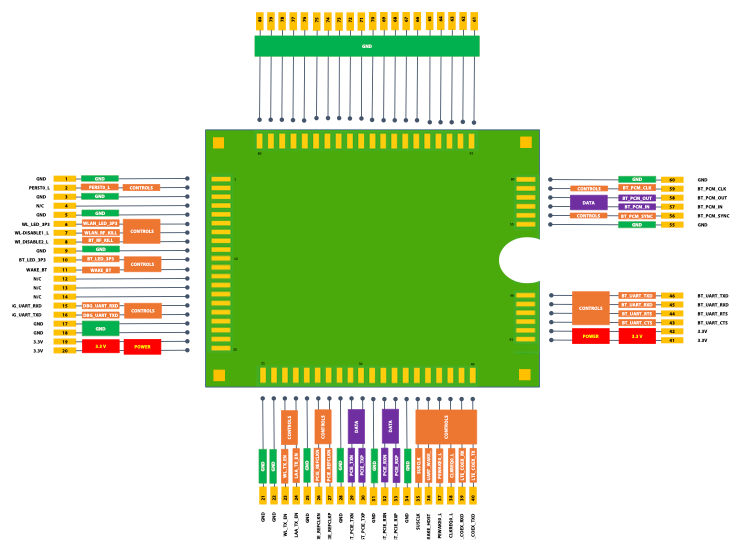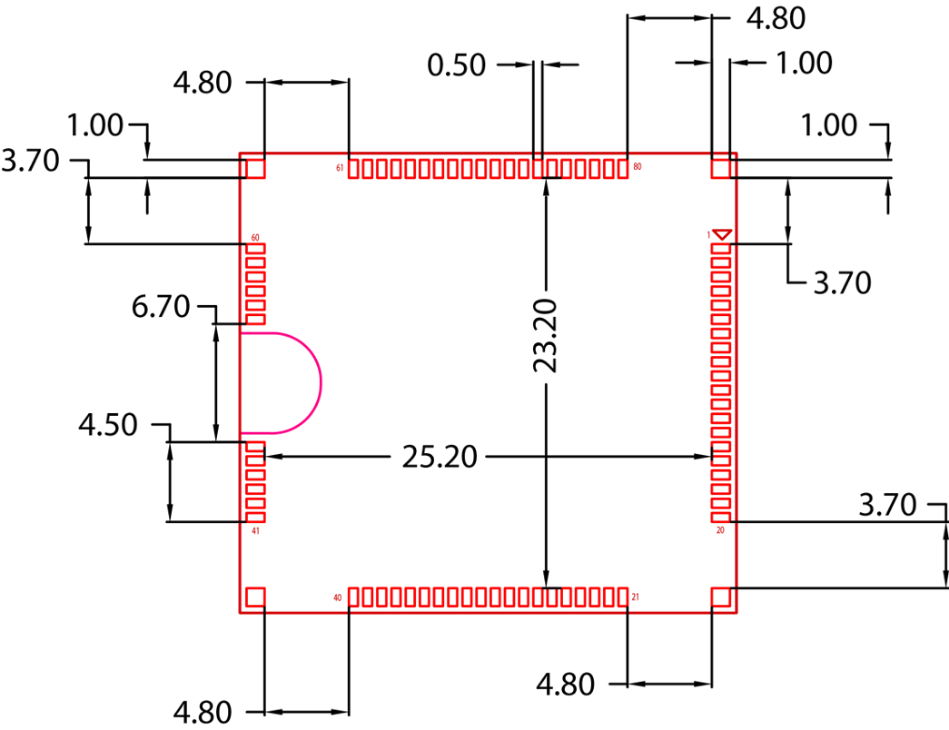SOLUTION DESIGN
Chipset: Qualcomm QCA6391
Standard: IEEE 802.11ax Wi-Fi 6 plus Bluetooth 5.2 Combo, full backwards compatibility to previous standards
Industrial Reference: Based on Qualcomm Atheros Hastings reference design
APPEARANCE
Communications Interface:
Pads: LGA or edge connector:
WLAN: via PCI Express Standard 2.1 host I/O
BT: via HCI UART and I2S (Virtual-USB mapping at SW level); PCM and I2C are available
Form Factor:
For E63B: SMD, Chip-on-Board, Soldered, Stamp down, Solder down “SIP type”, 2826 (28mm x 26m)
Others: Slotted, Socketed [CoB soldered on carrier]
ANTENNA
Configuration:
WLAN: Two Streams (2 chains), 2x2, 2 Connectors, MU-MIMO
BT: One Stream (1 chain); 1 Connector or co-existence with ANT0 Connector
Type: Three on-board U.Fl. connector receptables
WIRELESS PARAMETERS
Frequency Band:
WLAN:
2.4 GHz ISM Bands 2.412-2.472 GHz, 2.484 GHz
5.15-5.25 GHz (FCC UNII-low band) for US/Canada, Japan and Europe 5.25-5.35 GHz (FCC UNII-middle band) for US/Canada and Europe 5.47-5.725 GHz for Europe
5.725-5.825 GHz (FCC UNII-high band) for US/Canada
BT:
2402MHz~2480MHz
Data Transfer Rates:
WLAN:
802.11ax: Up to 1774.5Mbps (dynamic)
802.11ac: Up to 867Mbps (dynamic)
802.11n: Up to 300Mbps (dynamic)
802.11a/g: Up to 54Mbps (dynamic)
802.11b: Up to 11Mbps (dynamic)
BT:
GFSK at 1Mbp
π/4-DQPSK at 2Mpbs
8DPSK at 3Mpbs
Media Access Control: CSMA/CA with ACK
Channel:
2.4GHz: 1-13 (14 only for Japan)
5GHz: 36-64, 100-165
Channel Spacing: 5MHz, 10MHz, 20 MHz, 40Mhz selectable for 2.4Ghz band. 80Mhz is also available for the 5Ghz band.
Spreading / Modulation:
WLAN:
802.11ax: OFDMA (BPSK, adds 1024-QAM on MCS10 and MCS11)
802.11ac/g/n: OFDM (BPSK, DSSS-OFDM, QPSK,16-QAM,64-QAM, 256-QAM), MRC, STBC, LDPC, ML Demodulation
802.11b: CCK (11, 5.5Mbps), DQPSK (2Mbps), BPSK (1Mbps)
BT:
GFSK, π/4-DQPSK, 8DPSK
RF Output Power:
WLAN:
802.11b: 22.5 dBm at 11M ±2 dBm
802.11g: 20 dBm at 54M ±2 dBm
802.11a: 18.5 dBm at 54M ±2 dBm
802.11n/ax 2.4G V/HT20 20.5 dBm at MCS0 19 dBm at MCS7 ±2dBm
802.11n/ax 2.4G V/HT40 19 dBm at MCS0 17.5 dBm at MCS7 ±2dBm
802.11ax 2.4G VHT40 17.5 dBm at MCS0 15 dBm at MCS7 ±2dBm
802.11n/ac/ax 5G V/HT20 20.5 dBm at MCS0 19.5 dBm at MCS7 ±2dBm
802.11n/ac/ax 5G V/HT40 19.5 dBm at MCS0 17.5 dBm at MCS7 ±2dBm
802.11ac/ax 5G VHT80 17.5 dBm at MCS0 16.5 dBm at MCS9 ±2dBm
802.11ax 5G VHT80 16.5 dBm at MCS0 15 dBm at MCS11 ±2dBm
• DBm values reflect single RF chain output power performance. Two chain combined output power can be calculated as the single chain output power plus 3dB (2Tx = 1Tx + 3dB).
BT:
(Class 2 Mode) +2 dBm ≤ Output Power ≤ +6 dBm
(Class 1 Mode) +2 dBm ≤ Output Power ≤ +20 dBm
RF Receive Sensitivity (Typical, 1x1 chain):
WLAN:
802.11b 11M less than 91 dBm
802.11g 54M less than 77 dBm
802.11a 54M less than 77 dBm
802.11n/ax 2.4G V/HT20 MCS7 less than 77 dBm 95 dBm at MCS0
802.11n/ax 2.4G V/HT40 MCS7 less than 73.5 dBm 92.5 dBm at MCS0
802.11ax 2.4G VHT20 MCS9 less than 71.5 dBm, MCS11 less than 64 dBm 94.5 dBm at MCS0
802.11ax 2.4G VHT40 MCS9 less than 68 dBm, MCS11 less than 62 dBm 92 dBm at MCS0
802.11n/ac/ax 5G V/HT20 MCS7 less than 77 dBm 95 dBm at MCS0
802.11n/ac/ax 5G V/HT40 MCS7 less than 74.5 dBm 92.5 dBm at MCS0
802.11ax 5G V/HT20 MCS9 less than 70 dBm, MCS11 less than 64 dBm 85 dBm at MCS0
802.11ax 5G V/HT40 MCS9 less than 68 dBm, MCS11 less than 62 dBm 85 dBm at MCS0
802.11ax 5G V/HT80 MCS9 less than 62 dBm, MCS11 less than 59 dBm 85 dBm at MCS0
BT:
BER < 0.1% (Anritsu 8852B Tx -83Bm)
Operating Range:
Open Space: ~300 m; Indoor: :~100 m
(Coverage vary according to environment, antenna and topography)
Wireless Security:
WEP 64-bit and 128-bit encryption
WPA/WPA2/WPA3 UL/DL (Wi-Fi Protected Access)
MODALITIES
Infrastructure, AP/STA, Client, Bridge, Mixed-mode, P2P/Ad-hoc
SAFETY & REGULATORY
Compliant with FCC, CE RED, ISED, Japan TELEC and more.
Compliant with RoHS3.
PROTOCOLS
IEEE WLAN Network:
802.11ax, 802.11ac, 802.11n, 802.11g, 802.11b, 802.11a, 802.11d, 802.11e, 802.11h, 802.11i, 802.11k, 802.11r, 802.11u, 802.11v and 802.11w.
Other Standards:
Industry Standards:
HOST SYSTEM REQUIREMENTS
Operating System: Android/Linux Closed Source, Android/Linux Open Source, Qualcomm Embedded Platform, Windows, MacOS
ENVIRONMENTAL
Operating Temperature: -40 to +85 Celsius (depending on MPN)
Storage Temperature: -45 to +135 Celsius
Operating Humidity: 10% to 90% non-condensing
Storage Humidity: 5% to 90% non-condensing
ELECTRICAL
Power Consumption:
PROTOCOL RATE VOLTAGE 2x2 CTx 2x2 CRx 1x1 CTx 1x1 CRx
802.11b at 1Mbps 3.3V 667.0 mA 77.5 mA 372.4 mA 60.5 mA
802.11g at 6Mbps 3.3V 610.0 mA 88.5 mA 340.3 mA 71.4 mA
802.11a at 6Mbps 3.3V 665.1 mA 94.2 mA 385.5 mA 73.9 mA
802.11n on 2GHz at HT20, MCS0 3.3V 597.4 mA 87.2 mA 327.1 mA 70.1 mA
802.11n on 5GHz at HT20, MCS0 3.3V 639.6 mA 119.8 mA 369.8 mA 98.1 mA
802.11ac on 2GHz at VHT20, MCS7 3.3V 483.0 mA 87.4 mA 274.8 mA 70.4 mA
802.11ac on 5GHz at VHT40, MCS9 3.3V 611.3 mA 146.1 mA 358.9 mA 118.7 mA
802.11ax on 2GHz at HE40, MCS11 3.3V 460.5 mA 97.1 mA 286.8 mA 74.6 mA
802.11ax on 5GHz at HE80, MCS11 3.3V 553.0 mA 164.7 mA 333.1 mA 133.0 mA• Electronic current values in milliampere. Readings retrieved under stable, typical current and voltage.
• Power consumption ratings are statistical maximums in test system setups which are placed in continuous operating modes.
• Real-life application system power budgets are dependent on traffic mix, environment, topology and domain configuration.




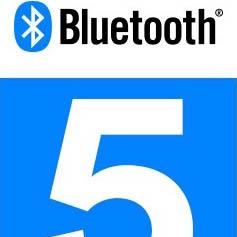












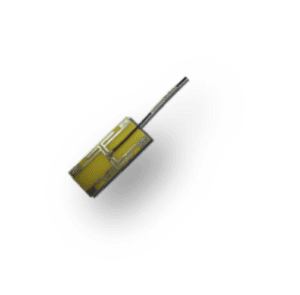

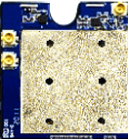







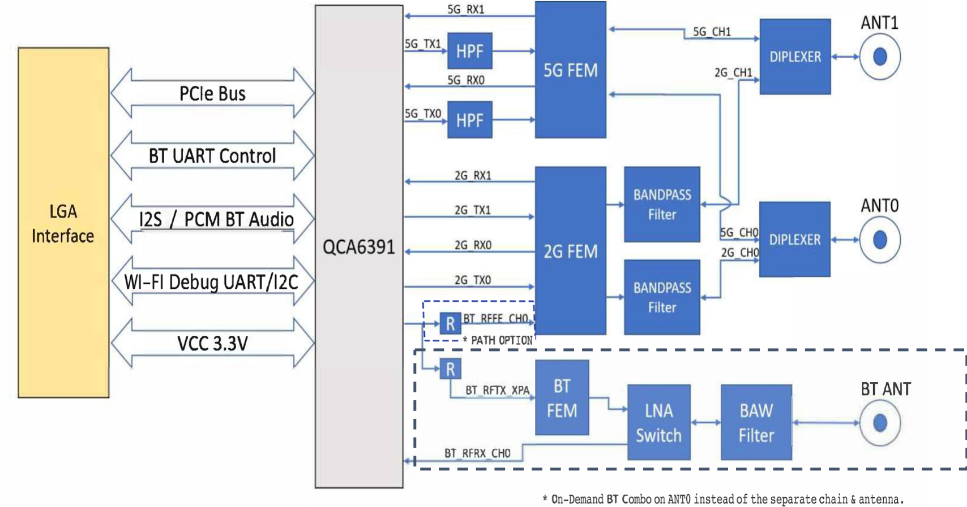 ** showing E63B LGA CoB Block Diagram with separate BT chain configuration.
** showing E63B LGA CoB Block Diagram with separate BT chain configuration. * showing E63B LGA CoB mechanical configuration.
* showing E63B LGA CoB mechanical configuration.